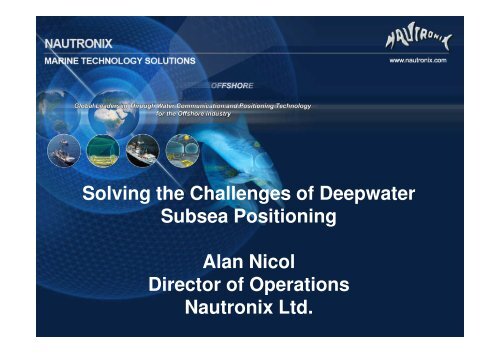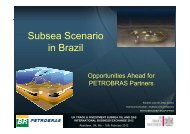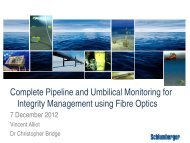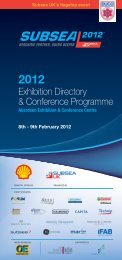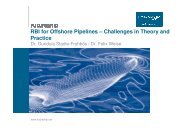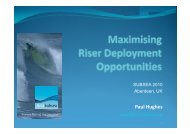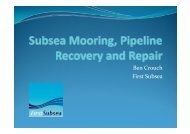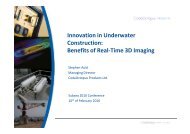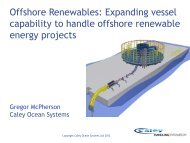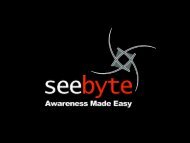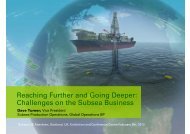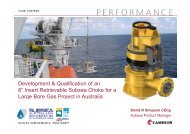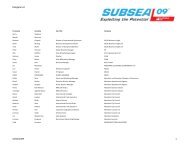nautronix - Subsea UK
nautronix - Subsea UK
nautronix - Subsea UK
You also want an ePaper? Increase the reach of your titles
YUMPU automatically turns print PDFs into web optimized ePapers that Google loves.
Solving the Challenges of Deepwater<br />
<strong>Subsea</strong> Positioning<br />
Alan Nicol<br />
Director of Operations<br />
Nautronix Ltd.
NAUTRONIX<br />
MARINE TECHNOLOGY SOLUTIONS<br />
Overview<br />
www.<strong>nautronix</strong>.com<br />
• Offshore Positioning Introduction<br />
• Considerations of Acoustic Positioning<br />
• The Commercial Drivers<br />
• Concepts and Technology behind NASNet®<br />
• Review of Offshore Deep Water Positioning Data<br />
• Summing Up
Offshore Positioning<br />
Introduction
NAUTRONIX<br />
MARINE TECHNOLOGY SOLUTIONS<br />
Real World Challenges<br />
• Developments in the industry:<br />
www.<strong>nautronix</strong>.com<br />
<br />
<br />
<br />
Deeper water<br />
Increased SIMOPS<br />
Increased CLOSEOPS<br />
• Increased focus on positioning and Station keeping<br />
• The requirements?<br />
<br />
<br />
<br />
Reliable<br />
Accurate<br />
Interference free
NAUTRONIX<br />
MARINE TECHNOLOGY SOLUTIONS<br />
Positioning Options<br />
www.<strong>nautronix</strong>.com<br />
• Satellites<br />
<br />
<br />
<br />
GPS<br />
GLONASS<br />
COMPASS<br />
• Acoustics<br />
<br />
<br />
<br />
LBL<br />
SBL<br />
USBL
Considerations<br />
of<br />
Acoustic Positioning Systems
NAUTRONIX<br />
MARINE TECHNOLOGY SOLUTIONS<br />
Acoustic Positioning Systems<br />
www.<strong>nautronix</strong>.com
NAUTRONIX<br />
MARINE TECHNOLOGY SOLUTIONS<br />
Accuracy<br />
www.<strong>nautronix</strong>.com<br />
• Accuracy is the closeness of the calculated position to the true position<br />
Accurate Measurement = Accurate Position?<br />
• Dependent on many variables<br />
Sound velocity<br />
Geometry<br />
Range measurement accuracy<br />
Latency<br />
Update rate<br />
Calculation method
NAUTRONIX<br />
MARINE TECHNOLOGY SOLUTIONS<br />
www.<strong>nautronix</strong>.com<br />
Accuracy - Sound Velocity<br />
• Acoustic systems measure distances (and sometimes angles)<br />
• Distance = time x speed (velocity)<br />
• SV in water approx 1500m/s<br />
<br />
Travel time 4 seconds in 3000m water<br />
0<br />
Sound Velocity (m/s)<br />
1480 1490 1500 1510 1520 1530 1540 1550 1560<br />
500<br />
1000<br />
Depth (m)<br />
1500<br />
2000<br />
2500<br />
3000
NAUTRONIX<br />
MARINE TECHNOLOGY SOLUTIONS<br />
Update Rate<br />
www.<strong>nautronix</strong>.com<br />
• The frequency with which new positions are generated from new data<br />
<br />
<br />
<br />
<br />
Provides more accurate dynamic positioning<br />
Increases consistency between sensors - reduces DP alarms!<br />
Improves fuel economy<br />
Allows increased weighting of acoustics in DP system<br />
• Workarounds<br />
<br />
<br />
Add additional, relative, sensors to ‘fill in the gaps’<br />
Use ‘stacking’ of acoustic pulses in the water column
NAUTRONIX<br />
MARINE TECHNOLOGY SOLUTIONS<br />
Latency<br />
www.<strong>nautronix</strong>.com<br />
• “The time delay between the moment something is initiated, and the<br />
moment one of its effects begins.”<br />
• Effectively the age of the position<br />
• An accurate but latent measurement can lead to an inaccurate<br />
position
NAUTRONIX<br />
MARINE TECHNOLOGY SOLUTIONS<br />
Latency<br />
www.<strong>nautronix</strong>.com<br />
• Interrogation
NAUTRONIX<br />
MARINE TECHNOLOGY SOLUTIONS<br />
Latency<br />
www.<strong>nautronix</strong>.com<br />
• Reply
NAUTRONIX<br />
MARINE TECHNOLOGY SOLUTIONS<br />
Latency<br />
www.<strong>nautronix</strong>.com<br />
• Calculate
NAUTRONIX<br />
MARINE TECHNOLOGY SOLUTIONS<br />
Battery Life<br />
www.<strong>nautronix</strong>.com<br />
• Battery life is approximately inversely proportional to power used<br />
• Therefore<br />
<br />
As volume and/or transmission rate goes up<br />
…battery life goes down<br />
• Reasons:<br />
<br />
<br />
<br />
Acoustic Noise<br />
Carelessness<br />
Multiple users (interrogators)<br />
• How do we make best use of the energy contained within the batteries?
NAUTRONIX<br />
MARINE TECHNOLOGY SOLUTIONS<br />
Battery Life<br />
www.<strong>nautronix</strong>.com<br />
• Smart adjustment of power<br />
<br />
<br />
Topside adjusts transponder power based on received S/N value<br />
Not good for multiple users of a transponder<br />
• Efficient and reliable signalling technology<br />
<br />
<br />
Spread spectrum – various flavours<br />
Prioritise from: distance, reliability & data transfer rate<br />
• More efficient use of each transmission – multiple users
Commercial<br />
Considerations
NAUTRONIX<br />
MARINE TECHNOLOGY SOLUTIONS<br />
www.<strong>nautronix</strong>.com<br />
Commercial Contributors<br />
• Vessel time/cost<br />
• Number of transponders<br />
<br />
Separation of transponders<br />
<br />
<br />
<br />
Redundancy levels<br />
Number of users<br />
Duration/maintenance level of units<br />
• Typical approaches:<br />
<br />
Each user provides their own system – no consistency<br />
<br />
Frames provided with multiple buckets - inefficient
NAUTRONIX<br />
MARINE TECHNOLOGY SOLUTIONS<br />
Typical Approach – 180 Transponders<br />
www.<strong>nautronix</strong>.com
NASNet® -<br />
Nautronix Acoustic<br />
<strong>Subsea</strong> Network
NAUTRONIX<br />
MARINE TECHNOLOGY SOLUTIONS<br />
www.<strong>nautronix</strong>.com<br />
NASNet® - The Concept<br />
• Acoustic Long Baseline (LBL) subsea positioning system<br />
Long range<br />
<br />
<br />
<br />
High accuracy<br />
True multi-user<br />
High signal integrity<br />
• Stations are deployed on the seabed<br />
like traditional systems<br />
• Ranges measured from multiple<br />
Stations to mobile objects<br />
• Positions calculated from range<br />
measurements
NAUTRONIX<br />
MARINE TECHNOLOGY SOLUTIONS<br />
Traditional LBL Approach<br />
www.<strong>nautronix</strong>.com<br />
• Two way communications<br />
– Station has to be interrogated<br />
before transmitting<br />
22
NAUTRONIX<br />
MARINE TECHNOLOGY SOLUTIONS<br />
NASNet® Approach<br />
www.<strong>nautronix</strong>.com<br />
• One way communications<br />
– Station transmits continually<br />
23
NAUTRONIX<br />
MARINE TECHNOLOGY SOLUTIONS<br />
www.<strong>nautronix</strong>.com<br />
NASNet® Approach<br />
• Station broadcast ‘transmit only’ technique<br />
<br />
<br />
Passive receive allows multiple simultaneous users (no ‘Frequency<br />
Management’)<br />
High update rates for all positioned objects (1-2 seconds)<br />
• ADS2 (Acoustic Digital Spread Spectrum) signalling<br />
<br />
<br />
<br />
Low Frequency reduces signal loss to absorption<br />
Accurate distance measurements and positioning<br />
Increased reliability with no interference to/from other systems<br />
• Long range capability<br />
<br />
<br />
Reduced numbers of seabed assets<br />
Time and cost savings for installation, calibration and maintenance
NAUTRONIX<br />
MARINE TECHNOLOGY SOLUTIONS<br />
Coverage Approach – 13 Seabed Units<br />
www.<strong>nautronix</strong>.com
NAUTRONIX<br />
MARINE TECHNOLOGY SOLUTIONS<br />
NASNet® Approach<br />
• LBL array of seabed units – Stations or Mini Stations<br />
www.<strong>nautronix</strong>.com<br />
• When turned on, Stations transmit without interrogation<br />
<br />
Battery<br />
<br />
<br />
Multiple receivers can use the same signal<br />
Advanced digital signalling techniques<br />
<br />
Latency<br />
<br />
One way ranges correct at moment of reception<br />
<br />
Update rate<br />
<br />
Position recalculated on reception of new range<br />
<br />
Accuracy<br />
<br />
<br />
QC information fed back to user<br />
Geometry monitored by system
NASNet® -<br />
Offshore Data Review
NAUTRONIX<br />
MARINE TECHNOLOGY SOLUTIONS<br />
NASNet® Vessel Positioning – 1500m WD<br />
www.<strong>nautronix</strong>.com<br />
• Effects of SV error and weak geometry on positioning accuracy<br />
• Stability, latency and update rate unaffected
NAUTRONIX<br />
MARINE TECHNOLOGY SOLUTIONS<br />
NASNet® Vessel Positioning – 2500m WD<br />
www.<strong>nautronix</strong>.com
NAUTRONIX<br />
MARINE TECHNOLOGY SOLUTIONS<br />
NASNet® Vessel Positioning – 1500m WD<br />
www.<strong>nautronix</strong>.com
NAUTRONIX<br />
MARINE TECHNOLOGY SOLUTIONS<br />
www.<strong>nautronix</strong>.com<br />
NASNet® Vessel Positioning – 2500m WD<br />
700<br />
600<br />
Frequency<br />
Cumulative %<br />
120.00%<br />
100.00%<br />
500<br />
80.00%<br />
Frequency<br />
400<br />
300<br />
60.00%<br />
200<br />
40.00%<br />
100<br />
20.00%<br />
0<br />
0.2 0.3 0.4 0.5 0.6 0.7 0.8 0.9 1 1.1 1.2 1.3 1.4 1.5 1.6 1.7 1.8 1.9 2 More<br />
Distance between systems (m)<br />
0.00%
Summing up
NAUTRONIX<br />
MARINE TECHNOLOGY SOLUTIONS<br />
In conclusion<br />
www.<strong>nautronix</strong>.com<br />
• Satellite systems are good...but not perfect especially with scintillation<br />
• Acoustics can be good, but the traditional approach has limitations in<br />
multi-user and deep water applications<br />
• NASNet® provides technological and commercial solutions to these<br />
constraints
NAUTRONIX<br />
MARINE TECHNOLOGY SOLUTIONS<br />
www.<strong>nautronix</strong>.com<br />
Thanks for Listening<br />
Questions?


